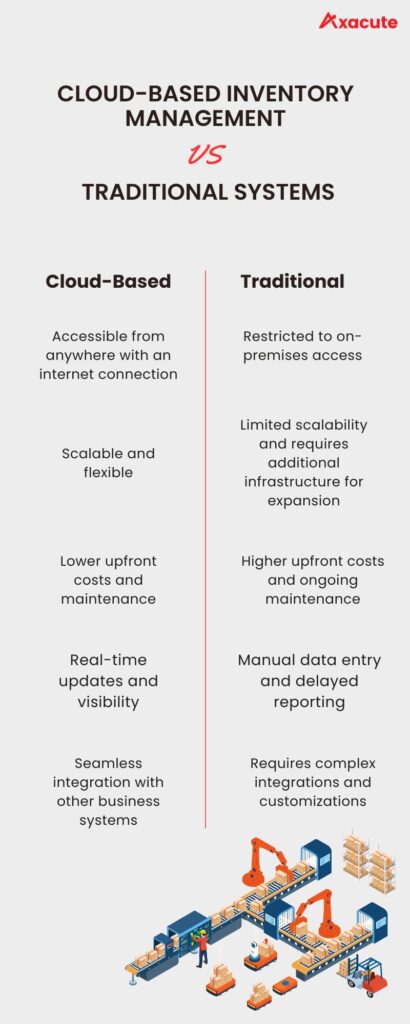
Cloud-based inventory management refers to the practice of storing and managing inventory data and processes in a cloud-based software system. This approach eliminates the need for on-premises infrastructure and provides businesses with the flexibility to access their inventory information anytime, anywhere, as long as they have an internet connection.
Before diving into the best practices, it’s essential to understand what SaaS implementation entails. SaaS refers to the delivery of software applications over the internet, where the provider hosts and maintains the software infrastructure. Warehouse management systems, inventory management tools, and supply chain solutions are common examples of SaaS applications used in warehouses.
Cloud-based solutions eliminate the need for expensive hardware installations and maintenance, reducing upfront costs and IT overhead.
Cloud-based systems can easily scale up or down to accommodate changing inventory needs, allowing businesses to adapt to growth or seasonal fluctuations.
With cloud-based inventory management, businesses can have real-time visibility into their inventory levels, locations, and movements, enabling accurate demand forecasting and inventory optimization.
Cloud-based systems automate manual tasks such as data entry, order processing, and inventory tracking, freeing up valuable time for employees to focus on more strategic activities.
Cloud-based inventory management enables seamless collaboration among team members and provides access to inventory information from multiple locations, fostering better communication and coordination.
Modern cloud-based inventory management systems typically offer a range of features to streamline inventory operations. Some key features include:
Cloud-based systems provide real-time visibility into inventory levels, allowing businesses to track stock movements, monitor stockouts, and prevent overstocking.
These systems leverage historical data and demand patterns to forecast future demand, enabling businesses to optimize their inventory levels and reduce holding costs.
Cloud-based inventory management systems streamline the order fulfillment process by automating order processing, tracking, and notifications.
These systems help businesses manage their relationships with suppliers, track supplier performance, and optimize procurement processes.
Cloud-based systems generate insightful reports and analytics, providing businesses with actionable insights to improve inventory performance, identify trends, and make data-driven decisions.
Cloud-based inventory management systems operate on a software-as-a-service (SaaS) model. Here’s a simplified overview of how they work:
Data Storage: Inventory data is securely stored in the cloud, accessible to authorized users via web browsers or dedicated mobile apps.
Real-Time Updates: Any changes to inventory levels, stock movements, or order statuses are instantly updated in the cloud-based system.
Integration: These systems often integrate with other business software, such as enterprise resource planning (ERP) systems, point of sale (POS) systems, and e-commerce platforms, ensuring seamless data flow across the organization.
User Roles and Permissions: Cloud-based inventory management systems provide different user roles and permissions to control access to sensitive inventory data.
Data Security: Robust security measures, such as encryption, authentication, and regular backups, are implemented to protect inventory data from unauthorized access or loss.
While cloud-based inventory management offers numerous benefits, there are some challenges to consider:
Internet Dependency: Cloud-based systems require a stable internet connection for real-time data access. Downtime or slow internet speeds can disrupt operations.
Data Security Concerns: Storing inventory data in the cloud raises security and privacy concerns. Businesses must carefully choose reputable vendors and implement proper security measures.
Integration Complexity: Integrating cloud-based inventory management with existing systems can be complex, requiring proper planning and expertise.
Training and Adoption: Employees need to be trained on how to use the new system effectively to maximize its benefits.
To ensure a successful implementation of cloud-based inventory management, consider the following best practices:
Define Goals and Objectives: Clearly define what you want to achieve with the new system and align it with your overall business objectives.
Choose the Right Vendor: Research and select a reputable vendor that offers the necessary features, scalability, and data security measures.
Plan Data Migration: Develop a data migration strategy to transfer existing inventory data to the new system accurately.
Train Employees: Provide comprehensive training to employees to ensure they understand how to use the system effectively.
Monitor and Evaluate: Continuously monitor the system’s performance, gather feedback from users, and make necessary adjustments to optimize its use.
Cloud-based inventory management differs from traditional on-premises systems in several ways:

Cloud-based inventory management systems find applications across various industries, including:
Retail and E-commerce: Streamlining inventory management, order processing, and supply chain operations for online and brick-and-mortar retailers.
Manufacturing: Optimizing inventory levels, managing raw materials, and tracking work-in-progress inventory for efficient production processes.
Wholesale Distribution: Enabling accurate inventory forecasting, improving demand planning, and facilitating efficient order fulfillment.
Logistics and Transportation: Managing inventory across multiple warehouses, optimizing routing, and improving visibility in supply chain logistics.
Healthcare: Tracking medical supplies and equipment, ensuring stock availability, and managing expiration dates in hospitals and clinics.
Cloud-based inventory management provides businesses with a modern and efficient approach to managing their inventory. It offers real-time visibility, automation, scalability, and cost-effectiveness. By implementing best practices and considering the challenges, businesses can leverage cloud-based inventory management to optimize their supply chain operations and stay competitive in today’s dynamic market.
Contact Us
Related
Get started with Axacute and improve your business operations.